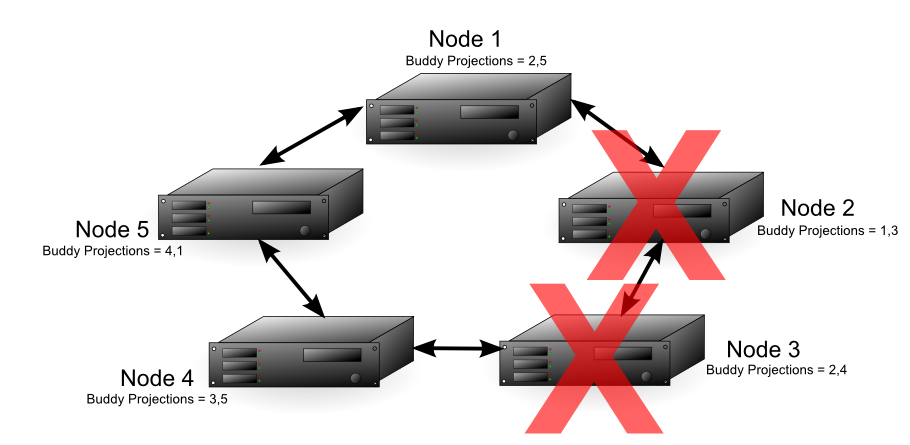K-safety in an Enterprise Mode database
K-safety sets the fault tolerance in your Enterprise Mode database cluster. The value K represents the number of times the data in the database cluster is replicated. These replicas allow other nodes to take over query processing for any failed nodes.
Note
K-safety works in a similar manner in an Eon Mode database, with several important differences. See Data integrity and high availability in an Eon Mode database for details.In Vertica, the value of K can be zero (0), one (1), or two (2). If a database with a K-safety of one (K=1) loses a node, the database continues to run normally. Potentially, the database could continue running if additional nodes fail, as long as at least one other node in the cluster has a copy of the failed node's data. Increasing K-safety to 2 ensures that Vertica can run normally if any two nodes fail. When the failed node or nodes return and successfully recover, they can participate in database operations again.
Note
If the number of failed nodes exceeds the K value, some the data may become unavailable. In this case, the database is considered unsafe and automatically shuts down. However, if every data segment is available on at least one functioning cluster node Vertica continues to run safely.Potentially, up to half the nodes in a database with a K-safety of 1 could fail without causing the database to shut down. As long as the data on each failed node is available from another active node, the database continues to run.
Note
If half or more of the nodes in the database cluster fail, the database automatically shuts down even if all of the data in the database is available from replicas. This behavior prevents issues due to network partitioning.Note
The physical schema design must meet certain requirements. To create designs that are K-safe, Vertica recommends using the Database Designer.Buddy projections
In order to determine the value of K-safety, Vertica creates buddy projections, which are copies of segmented projections distributed across database nodes. (See Segmented projections and Unsegmented projections.) Vertica distributes segments that contain the same data to different nodes. This ensures that if a node goes down, all the data is available on the remaining nodes.
K-Safety example
This diagram above shows a 5-node cluster with a K-safety level of 1. Each node contains buddy projections for the data stored in the next higher node (node 1 has buddy projections for node 2, node 2 has buddy projections for node 3, and so on). If any of the nodes fail, the database continues to run. The database will have lower performance because one of the nodes must handle its own workload and the workload of the failed node.
The diagram below shows a failure of Node 2. In this case, Node 1 handles processing for Node 2 since it contains a replica of node 2's data. Node 1 also continues to perform its own processing. The fault tolerance of the database falls from 1 to 0, since a single node failure could cause the database to become unsafe. In this example, if either Node 1 or Node 3 fails, the database becomes unsafe because not all of its data is available. If Node 1 fails,Node 2's data is no longer be available. If Node 3 fails, its data is no longer available, because node 2 is down and could not use the buddy projection. In this case, nodes 1 and 3 are considered critical nodes. In a database with a K-safety level of 1, the node that contains the buddy projection of a failed node, and the node whose buddy projections are on the failed node, always become critical nodes.

With Node 2 down, either node 4 or 5 could fail and the database still has all of its data available. The diagram below shows that if node 4 fails, node 3 can use its buddy projections to fill in for it. In this case, any further loss of nodes results in a database shutdown, since all the nodes in the cluster are now critical nodes. In addition, if one more node were to fail, half or more of the nodes would be down, requiring Vertica to automatically shut down, no matter if all of the data were available or not.

In a database with a K-safety level of 2, Node 2 and any other node in the cluster could fail and the database continues running. The diagram below shows that each node in the cluster contains buddy projections for both of its neighbors (for example, Node 1 contains buddy projections for Node 5 and Node 2). In this case, nodes 2 and 3 could fail and the database continues running. Node 1 could fill in for Node 2 and Node 4 could fill in for Node 3. Due to the requirement that half or more nodes in the cluster be available in order for the database to continue running, the cluster could not continue running if node 5 failed, even though nodes 1 and 4 both have buddy projections for its data.

Note
Vertica requires that more than half of all nodes in a cluster must always be available; otherwise, it views the database as being in an unsafe state and shuts it down. Thus, in the previous example, the cluster cannot continue running if Node 5 fails, even though nodes 1 and 4 have buddy projections for its data.Monitoring K-safety
You can access System Tables to monitor and log various aspects of Vertica operation. Use the
SYSTEM table to monitor information related to K-safety, such as:
-
NODE_COUNT: Number of nodes in the cluster -
NODE_DOWN_COUNT: Number of nodes in the cluster that are currently down -
CURRENT_FAULT_TOLERANCE: The K-safety level